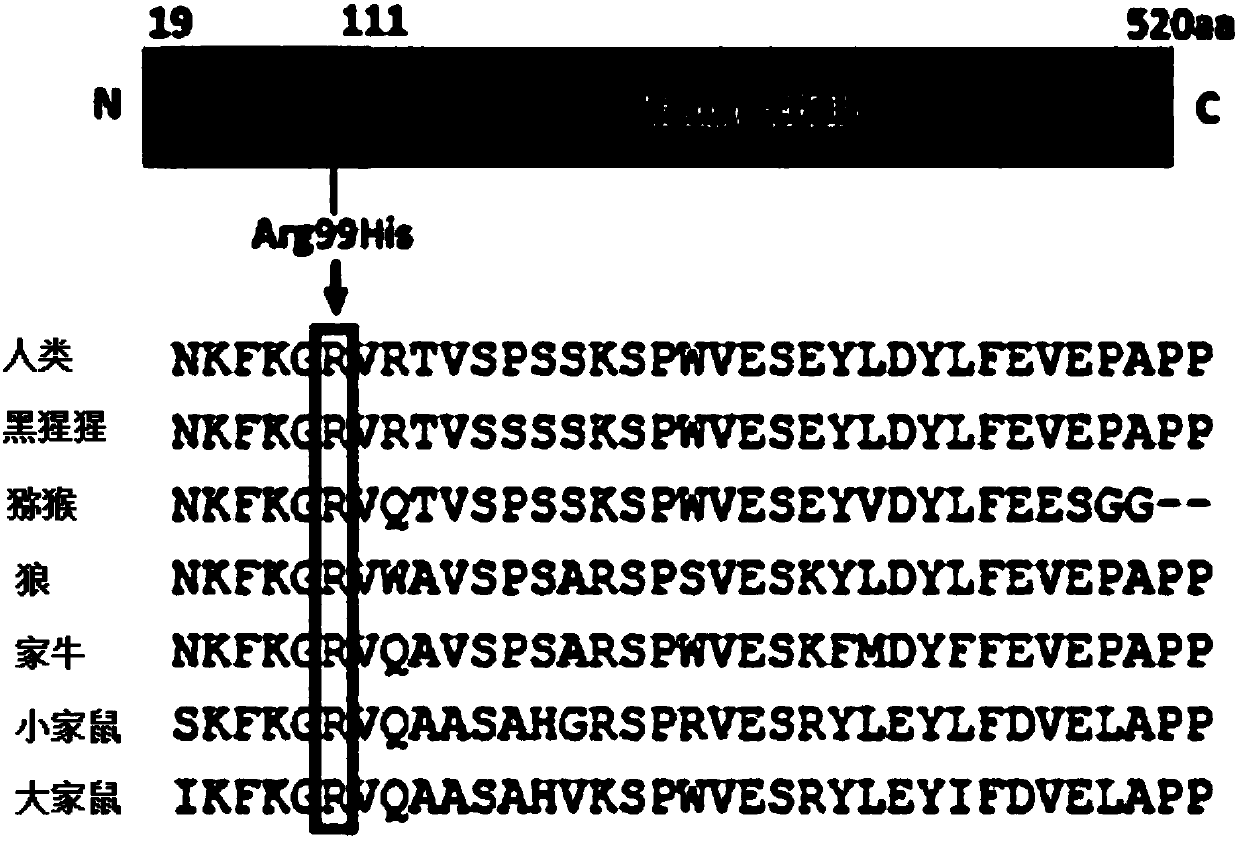Separated encoded IFNLR1 mutant nucleic acid and application thereof
A mutant and nucleic acid technology, applied in the field of susceptibility to non-syndromic autosomal dominant genetics, can solve problems such as unknown disease-causing gene loci, and achieve the effect of broadening the scope of clinical diagnosis and detection/screening
- Summary
- Abstract
- Description
- Claims
- Application Information
AI Technical Summary
Problems solved by technology
Method used
Image
Examples
Embodiment 1
[0079] Example 1 Whole Exome Sequencing Determination of Disease-causing Genes and Mutation Sites
[0080] 1. Sample collection
[0081] The inventor collected a pedigree of Chinese Han hereditary deafness with morbidity for three consecutive generations (see the pedigree for the pedigree) figure 2 ), the family consists of 24 members, including 10 confirmed patients and 9 existing patients (diagnostic diagram see image 3 ), collected the peripheral blood samples of the family members, among which the collected blood samples were 9 cases (II:2, II:3, II:4, II:5, II:6, III:3, III:5 , III:6, III:7); collected 14 cases of phenotype normal human blood samples (I:2, II:1, II:7, II:8, II:9, II:10, II:11 , II:12, III:1, III:2, III:4, III:8, III:9, III:10). 2 mL of peripheral blood samples were collected from each sample, added with EDTA for anticoagulation, and stored at -80°C.
[0082] in, figure 2 The pedigree chart is shown, where ○ indicates a normal female, □ indicates a...
Embodiment 2
[0108] Example 2 Sanger method sequencing to verify the pathogenic mutation of ADNSHL disease
[0109] The IFNLR1 gene obtained in the detection of Example 1 was detected respectively, primers were designed for the sequence of the mutation site involved in the above gene, and then the relevant sequence of the above mutation was obtained by PCR amplification, product purification and sequencing, and the determined sequence was determined according to the result Whether it is mutant or wild type, whether it is heterozygous mutation or homozygous mutation, and whether the sequence and phenotype are co-segregated in the family to verify the correlation between the above genes and ADNSHL.
[0110] 1. DNA extraction
[0111] Collect 10ml of peripheral venous blood, use OMEGA Blood DNA Midi Kit whole blood DNA extraction kit to extract genomic DNA, and use spectrophotometer and gel electrophoresis to measure the concentration and purity of DNA and dilute to 200ng / μl;
[0112] 2. Pri...
Embodiment 3
[0128] IFNLR1 gene expresses Interferon lambda receptor 1 (Interferon lambda receptor 1) protein, which is related to the recognition of cytokines and interferon in the extracellular environment and intracellular signal transduction. , the spiral ganglion and the vestibular epithelium of the inner ear. Its functions include antiviral activity, antiproliferation, anticancer activity, molecular expression of MHC (major histocompatibility complex) complex I / II, and immune response. So far, the role of IFNLR1 in the auditory system has not been discovered.
[0129] In order to further study the function of IFNLR1 in the auditory system, the present invention uses a mouse model to study the expression and distribution of IFNLR1 in the inner ear of the mouse by means of fluorescent labeling, and finds that the IFNLR1 gene is widely expressed in the cochlea and the spiral organ.
[0130] Using the zebrafish model, the IFNLR1 gene mutant zebrafish was compared with the wild-type zebr...
PUM
 Login to View More
Login to View More Abstract
Description
Claims
Application Information
 Login to View More
Login to View More - Generate Ideas
- Intellectual Property
- Life Sciences
- Materials
- Tech Scout
- Unparalleled Data Quality
- Higher Quality Content
- 60% Fewer Hallucinations
Browse by: Latest US Patents, China's latest patents, Technical Efficacy Thesaurus, Application Domain, Technology Topic, Popular Technical Reports.
© 2025 PatSnap. All rights reserved.Legal|Privacy policy|Modern Slavery Act Transparency Statement|Sitemap|About US| Contact US: help@patsnap.com



